May 23, 2019 | Advice, Advice for Writers, Editor, Editors' Blog, Expert, Fantasy, Horror, Literary, Paranormal, Sci-fi, Thriller, Uncategorized
 When it comes to marketing a horror movie, the trailer is everything. A good trailer can be shared all over social media and attract just the right audience to go and see it. Promoting a horror novel is much the same. Here are 5 marketing tactics horror movies use that you can also use to promote your horror novel.
When it comes to marketing a horror movie, the trailer is everything. A good trailer can be shared all over social media and attract just the right audience to go and see it. Promoting a horror novel is much the same. Here are 5 marketing tactics horror movies use that you can also use to promote your horror novel.
5 – Show Audience Testimonials and Ratings
A lot of movie trailers show quotes from critics praising the movie. This technique is commonly used to sell books as well.
One technique that has become a best practice is to start your book description on Amazon with a quote praising the book or your work. You can also put additional quotes on your book cover and at the bottom of your book description.
You can get quotes by pulling from favorable reviews or by reaching out to other authors. Many authors will be happy to blurb your book in exchange for a free copy.
4 – Creativity Can Be More Effective than Money
There's a reason a lot of up and coming directors start with a horror movie: small budgets. With a little creativity, there are ways to make a good horror movie without spending a lot of money. Look at movies like The Blair Witch Project and Paranormal Activity. Both had tiny budgets and both found humongous success.
There are a lot of great promotional sites for authors, including BooksGoSocial, but there's also something to be said for being creative. You may be able to find a fun and creative way to promote your book on social media without spending a lot of money.
I photoshopped this image to help promote my horror novel, Violent Hearts, and it drew a lot more traffic, likes and comments, then a regular book cover post.

“Bradbury on acid.” Greg Gifune, author of The Bleeding Season
3 – Show Your Characters
Horror movie trailers often revolve around their characters. If they can make you care about what happens to these characters, you are much more likely to go and see the movie.
Same is true for books. Be sure to include details about your characters in your book description and promotions that will make your audience sympathetic to your characters.
2 – Use Mystery to Entice Readers to Buy
Horror movie trailers often hit us with something unexpected and mysterious. Where did that come from? What is causing that? These questions draw us into the story and make us want to go and see the movie.
You can offer excerpts and short cliffhanger teasers on your social media feeds to build an audience and entice readers to buy your book.
Here's one I've used to promote my horror novel, Violent Hearts:
It started that cold night spent in the woods, all those years ago. Owen and Chloe wakened something, something inside them both. But, for a while at least, they thought they could live normal lives…
Click here.
1 – Give Readers What They Want
 Same is true for promoting your book. Give your readers characters they care about, with sympathetic backgrounds you can sum up in a few words you can use in your book description. This helps to put a “face” to your characters and give them life for your readers.
Same is true for promoting your book. Give your readers characters they care about, with sympathetic backgrounds you can sum up in a few words you can use in your book description. This helps to put a “face” to your characters and give them life for your readers.
We've all seen movie trailers that give away too much of the plot. Don't be that person. Instead, tell them what the blood and guts are in your book.
When someone picks up your book, what's in it for them? Tell them! Be explicit. If your book is an exciting adventure, then tell them it's an exciting adventure. If your book has uncanny hauntings or violent gore, don't be afraid to share this fact. Not only will you keep away readers who don't like such things and might leave bad reviews, but you will get the right readers interested in your book.
 Keith Deininger is the award-winning and #1 Amazon bestselling author of many horror and fantasy titles, including WITHIN, THE FEVER TRILOGY and THE GODGAME series. He has been called “one of the finest writers of imaginative fiction” and “Ray Bradbury on acid.” His latest novel, VIOLENT HEARTS, has been compared to Stephen King’s fantasy-based work. He lives in Albuquerque, NM with his wife and kids. Although he loves a good nightmare, in person he’s a really nice guy. Promise.
Keith Deininger is the award-winning and #1 Amazon bestselling author of many horror and fantasy titles, including WITHIN, THE FEVER TRILOGY and THE GODGAME series. He has been called “one of the finest writers of imaginative fiction” and “Ray Bradbury on acid.” His latest novel, VIOLENT HEARTS, has been compared to Stephen King’s fantasy-based work. He lives in Albuquerque, NM with his wife and kids. Although he loves a good nightmare, in person he’s a really nice guy. Promise.
Keith’s personal site: www.KeithDeininger.com
Keith’s SEO content and editing company: www.MeridianPublications.com
Oct 8, 2018 | Editors' Blog, Historical, Literary
This book is fiction. The story that inspired it was not.
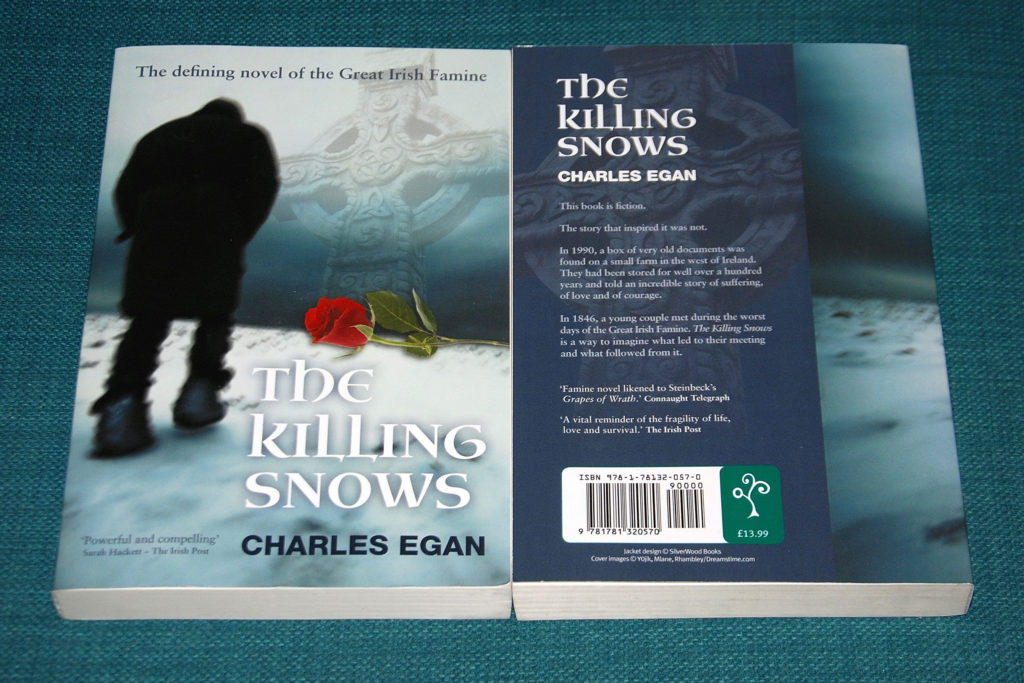
In 1990, I came into possession of two documents which were fascinating, and in their own way, quite savage.
My father had been brought up on a small farm in County Mayo in the West of Ireland. Following the death of one of his brothers, he gave us a box of documents which, by their dates, had been stored for over a hundred years. They included a lease, a number of letters and two payrolls from the 1840s.
It was with a sense of shock that I realized what they really were. These were the documentary evidence of the Great Irish Famine in East Mayo. They were also the confirmation of the stories I had learned as a child as to how my family survived the Famine.
The two payrolls were the most horrific. They detailed the wages for gangs of men, women, and children working on two roads in east Mayo in the winter of 1846. The desperately low rates of pay – as low as three pennies a day – proved that this was Famine Relief. Local research filled in more of the story, a brutal one of hunger, fever, and death.
The Irish Famine had started with the partial failure of the potato crop in the autumn of 1845. In 1846 the potato failed again, and this time the failure was nearly total.
The Workhouses could not cope, and so the enormous Famine Relief schemes were started, and kept running through the coldest and worst winter of the past 300 years. Hundreds of thousands of starving people were employed on roadworks, building and repairing roads all across Ireland.
 Hunger killed thousands of them. The murderous blizzard of December 1846 killed many thousands more and brought the Works to a halt all across the country. But they opened again in January 1847, and the arctic cold went on. By the time the soup kitchens took over in March, the Works were employing three-quarters of a million survivors, mostly in the West of Ireland, all trying desperately to feed their families on pitifully low wages. Then, as the winter receded, a vicious fever epidemic killed hundreds of thousands of people right across Ireland. 1846 was shocking, but Black ’47 would never be forgotten.
Hunger killed thousands of them. The murderous blizzard of December 1846 killed many thousands more and brought the Works to a halt all across the country. But they opened again in January 1847, and the arctic cold went on. By the time the soup kitchens took over in March, the Works were employing three-quarters of a million survivors, mostly in the West of Ireland, all trying desperately to feed their families on pitifully low wages. Then, as the winter receded, a vicious fever epidemic killed hundreds of thousands of people right across Ireland. 1846 was shocking, but Black ’47 would never be forgotten.
Research also confirmed an old family tradition which I had never believed. This was the story of an utterly impossible love set against the terror of the times. So in the end ‘The Killing Snows’ is much more than historical fiction. It is an attempt to understand how such a love could have happened and how the impossible became true.
Charles Egan
Lesley Tither
Sep 17, 2018 | Editors' Blog, Historical, Literary
it was the night before Christmas. And I was in bed with a policeman.
A virtual policeman, I hasten to add.
I was having one of those intense dreams. You know the ones. Where you’re conscious, on some level, that it is a dream. But it’s so good you keep saying to yourself you must remember it because it would make an amazing book.
There was all the detail there for a gripping crime thriller. Plot, characters, sub-plots. One character in particular was most persistent in making himself known and he came with a full back-story. His name was Ted Darling, a former Specialist Firearms Officer, now a Detective Inspector in the Great Manchester Police, stationed at Stockport. The town where I grew up and, occasionally, went to school. That was useful, as it meant less research for me in writing about it.
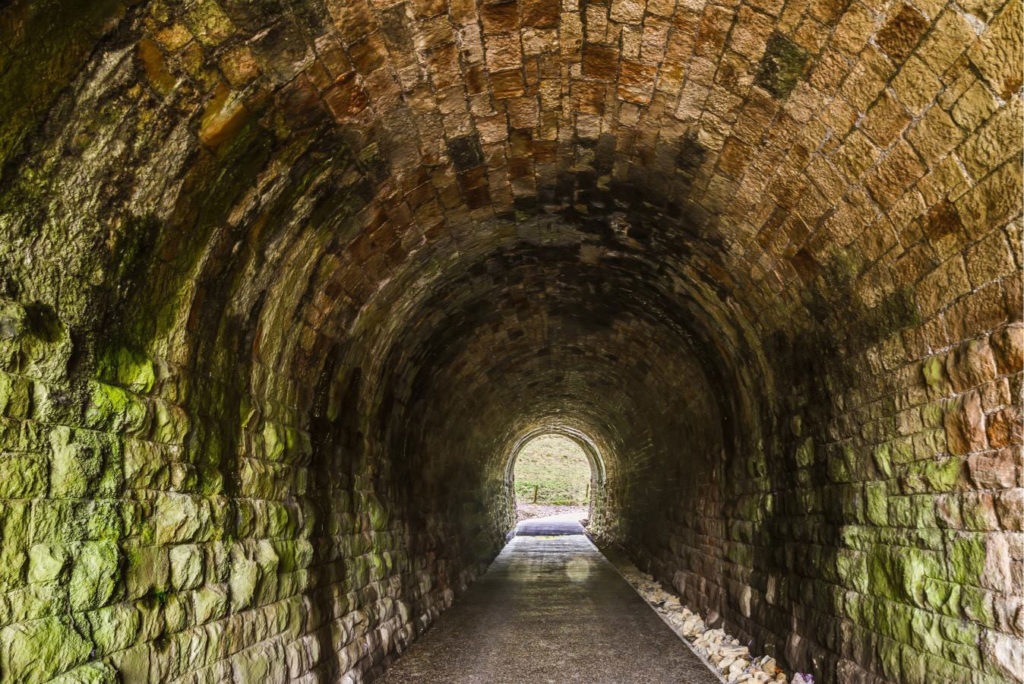
Stockport has some great architectural features for book covers, like this wonderfully spooky tunnel
Even though I was sleeping, I was still analysing thought processes. I knew where this dream was coming from, deep in my subconscious. Probably only accessible as I slept.
Crime fiction has always been my preferred genre, both to read and to watch on television. I grew up on Agatha Christie and Ngaio Marsh. I had never contemplated writing it, although I was, at this time, an author of travel memoirs.
I’d been growing increasingly disillusioned of late at the lack of originality in the crime fiction I read. The days of the heavy-drinking copper had been done well, but done to death, by the likes of Ian Rankin’s Rebus character. The growing new breed of women detectives was already merging into one stereotype. Ballsy, bolshie, always at odds with their bosses. Going off like lone she-wolves on dangerous solo crusades. I know it’s fiction, but I like a note of reality in it. And characters like that these days would be on a disciplinary in no time.
Ted Darling was different. He was also, as I was soon to discover, very persistent. Pecking away at the inside of my head to make himself noticed. He was shorter than average and slightly built. Didn’t drink, smoke or gamble. Certainly never played away. He’d been in a steady relationship for eleven years. He and his partner had cats, not kids.
And so the dream unfolded. By some miracle, when I woke up, it was all still fresh in my mind. I live alone with my dog (dogs now) so I had no festive commitments. I took Fleur, my rescued border collie, for a quick walk. Then I sat down at my computer and start to write.

Fleur, the blonde bombshell, my rescued border collie
I sent the first chapter to my friend and beta-reader. She asked for more.
And so it’s continued for three years now. Eleven books on, and Ted still popping into my head while I’m trying to sleep.

Lesley Tither, who writes the Ted Darling Crime series under the pen-name L M Krier
Lesley Tither is a former journalist (court reporter), Freelance copywriter/copy editor who also worked for the Crown Prosecution Service at its inception. She now lives in Central France with her two rescued border collies, Rosie and Fleur. The First Time Ever is the first book in the popular Ted Darling Crime Series.
William L. Taylor, Alaska Historian
Sep 11, 2018 | Editors' Blog, Historical, Literary
For anyone interested in the American Frontier and the people who created the United States, Hazelets' Journal provides a lively and absorbing account of an important part of that unique time. There is a good discount on copies of the print edition of Hazelet's Journal at this link.
Although the highly detailed maps of the Geological Survey which accompany this volume give a superb pictorial view of the country through which Hazelet traveled, and his own narrative gives the best description I have seen from any source, it may be of some interest to provide here a brief outline of the early examination of the country by way of an introduction to the book.

Hazelet- Meals cabin, Lower Claim, 1900.
The Copper River region generally suffered in public notice in 1897 and the years following, and was far out-shone in effort and production by the Klondike, Nome and Fairbanks and even by a number of the lesser diggings. The Chistochina gold field however eventually produced handsome returns which in itself is a tribute to Hazelet's unerring judgment and skill as a prospector, and in 1900 with the discovery of the Bonanza Copper fields by the McClellan party brought the area to national prominence.
At the time this journal was written the country was known only through the cursory reconnaissance surveys of Abercrombie in 1884 and Allen in 1885, both for the U. S. Army, so accurate mapping of the area was not accomplished until 1900 when the Geological Survey undertook that task, and the results of the survey were not published until a number of years later.
Valdez Arm had been first visited and named in 1790 by the Spaniard DeHaro, but it was not until the winter of 1897 that a settlement came into being there with the first trickle of prospectors attempting to enter the basin of the Copper River through the back country of Valdez. Before l898 was over, 3000 men had made the attempt, and the trail over the glacier is said to still show evidence of that trek by the debris left along the route. A post office was established at Valdez in July 1899, and the town was incorporated July 1st, 1900 with a recorded population of 315 souls.

Shooting the Klutina, Courtesy of Valdez Museum & Historical Archive. Image restoration by J. H. Clark.
The foot of the glacier at 500 feet elevation lies about five miles from tidewater and rises abruptly in successive glacial ledges or benches to the summit, 13 1/2 miles distant in a northerly direction. Beyond the summit the glacier, here named Klutina, slopes downward for another six miles where at 2500 feet it drains into the Klutina River and Lake. The Klutina was first reported by Allen in 1885, although he had seen only the issuance of this tributary into the Copper.
The Copper River was first noticed by the Russian, Nagaief, in 1781, and given the name on account of the reported existence of that metal in its vicinity. Its native name was Atna or Aetna; the Spaniards had called it Rio de los Perdidos. No whites had travelled it until the summer of 1884 when Captain William R. Abercrombie, 2nd Inf., USA ascended the stream from its mouth to latitude 60 o, 41′, a mere 17 miles to the vicinity of Miles Glacier where he was halted by the rapids.
To clarify and extend Abercrombie’ s observations, the Army in the following summer sent Lieut. Henry T. Allen with two enlisted men to follow the river to its source. Leaving Nuchek on Hinchinbrook Island on March 20, 1885 in native skin boats, and accompanied by the trader Peder Johnson who acted as interpreter, the party took two months to negotiate the 160 miles which brought them to the confluence with the Klutina where Hazelet entered the Cooper.
Allen's account of this passage recounts difficulties similar to those of Hazelet, if less vividly told, and confirmed the nature of the Copper's watercourse in an exceptionally rapid fall for its entire length. Between Allen's Camps 8 and 9, which were ten miles apart, the observed fall was 110 feet. Allen's sketch map is the basis for the modern nomenclature of the principal tributary streams, and for many of the mountains seen and triangulated from the river. Except in the case of the mountains, Allen retained in essential form the native names. He found the natives, the Atnatanas, almost as hungry and ill provided a lot as his own party. His report was published in 1887 as Senate Ex. Doc. No. 125, Forty Ninth Congress, Second Session.

George Cheever Hazelet aboard his faithful horse Keno.
In 1898, Captain Abercrombie was again sent into this region with a detachment of thirteen men to open a military road from Valdez to the interior. This party, after a futile attempt to make a stable trail over the glacier, surveyed the Keystone Canyon and Thompson Pass now followed by the Richardson Highway and with hand tools cleared a trail and built wooden bridges to form a passable pack and dog team trail. At the time, Hazelet entered the country the sole extant map of it was Allen's, and this delineated only the Copper River itself and what could be seen from the river, i.e., the tributaries as they entered the Copper River Country and the high mountains to the east.
The glaciers, lakes and rivers between Valdez and Copper Center were only known from the Indians and the few whites who had gone over the glacier in 1897. In the entry for May 22, 1898, Haze1et informs us of his surprise at learning the Indian name of Kutina for the lake they were camped upon, he and others there having been under the impression they were on the Tonsina. Nowhere in the journal does Hazelet speak of a map, a surprising fact for one of his intelligence and orderly mind.
Yet I feel he must have had one, and if so probably a copy of Allen's, since he unerringly identifies the tributaries as he works up the Copper. That he gives these streams the Indian names as had Allen, is no clear indication that he got them direct from the natives, although he appears to have cultivated certain of these friendly people, for the high peaks of Drum, Sanford and Wrangell are assigned correct names and bearings from his points of observation. There are, however, two curious exceptions to indicate that his Indian contacts were not ignored.
The first is the Klawosinak River of Hazelet which Allen renders as Klawasi. If the common native “na” ending, meaning river be added, the variation is reduced to Hazelet’s providing the final hard “k” an easily understandable rendering of the gutterals that he encountered among them. The second variation is Hazelet's rendering of the Tsina River as Chena, which although phonetically reasonable, anticipates the name of that famous stream in the Fairbanks area by several years.
For those interested in reading more, there is a good discount on copies of the print edition of Hazelet's Journal at this link.
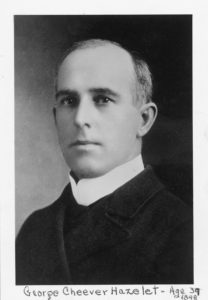
Catherine Kullmann
Aug 2, 2018 | Historical, Literary
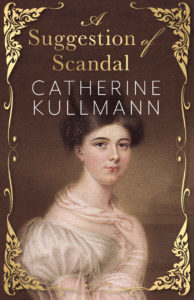 The simplest way to describe the Regency is ‘the period between hoops and crinolines’. Beautiful Empire gowns, light muslins, gentlemen in severely tailored riding clothes and highly polished boots, Mr Darcy and Elizabeth Bennet, waltzes, quadrilles and the Battle of Waterloo.
The simplest way to describe the Regency is ‘the period between hoops and crinolines’. Beautiful Empire gowns, light muslins, gentlemen in severely tailored riding clothes and highly polished boots, Mr Darcy and Elizabeth Bennet, waltzes, quadrilles and the Battle of Waterloo.
But it is so much more than that.
Although the actual Regency during which the Prince of Wales (later King George IV) acted as regent for his father, the incapacitated King George III, only lasted from 1811 to 1820, the Regency era, characterised by distinctive trends in British architecture, literature, fashions, politics, and culture could be said to cover the period from the Prince’s marriage in 1795 to the death of his successor King William IV in 1837.
The events of this significant period of European and American history still resonate after two hundred years. The Act of Union between Great Britain and Ireland of 1800, the Anglo-American war of 1812 and the final defeat of Napoleon at the Battle of Waterloo in 1815 all continue to shape our modern world.
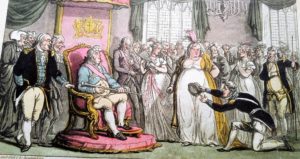 Society in the new United Kingdom was dominated by the aristocracy and great landowners who not only filled the House of Lords but also, through an unequal franchise coupled with outdated constituency borders, controlled much of the House of Commons. In The Age of Elegance, Arthur Bryant says, “Little more than 400,000 out of the English and Welsh population of 10 1/2 million enjoyed a parliamentary vote and only 4000 out of 2 million Scots”.
Society in the new United Kingdom was dominated by the aristocracy and great landowners who not only filled the House of Lords but also, through an unequal franchise coupled with outdated constituency borders, controlled much of the House of Commons. In The Age of Elegance, Arthur Bryant says, “Little more than 400,000 out of the English and Welsh population of 10 1/2 million enjoyed a parliamentary vote and only 4000 out of 2 million Scots”.
Reform was slow in coming and several times during this period Great Britain teetered on the brink of insurrection and civil war. The Habeas Corpus Acts, which required a person under arrest to be brought before a judge or into court, especially to secure the person's release unless lawful grounds are shown for their detention, were suspended regularly resulting, as one diarist noted, in ‘Many people taken up in England for Sedition & Treason’. The acts were suspended 1794 and 1798, reinstated in 1802 with the release of most of the imprisoned radicals, and suspended again in 1817.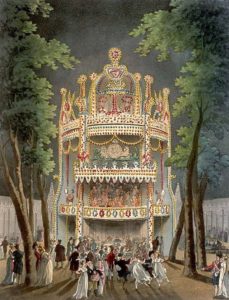 A series of ‘Gagging Acts’ sought to prevent any hint of sedition and libel. The military were used to suppress demonstrations, culminating in the infamous Peterloo massacre in 1819 when cavalry charged the crowd at a reform meeting in Manchester, leaving over four hundred injured and eleven to fifteen people dead, including a two-year-old boy.
A series of ‘Gagging Acts’ sought to prevent any hint of sedition and libel. The military were used to suppress demonstrations, culminating in the infamous Peterloo massacre in 1819 when cavalry charged the crowd at a reform meeting in Manchester, leaving over four hundred injured and eleven to fifteen people dead, including a two-year-old boy.
The long process of Catholic emancipation from the Penal Laws was completed in 1829 with the Roman Catholic Relief Act, and Catholics were finally able to take their seats in both houses of parliament. 1832 saw the beginning of political reform when the Reform Act extended the franchise to more than the select few as well as redrawing constituency borders and doing away with pocket boroughs. Some parts of the new United Kingdom were still more equal than others, however; in 1833, one in five Englishmen had the vote, one in eight Scotsmen and one in twenty Irishmen.
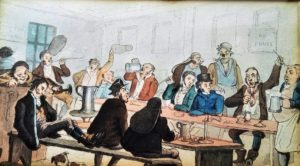 The Napoleonic wars lasted twelve years. Unlike the other combatants, the UK was spared the havoc wrought by an invading army and did not suffer under an army of occupation. The war happened elsewhere, far away. People were generally unaware of its progress—the only available news was that provided in official dispatches published in The Gazette and other newspapers and the occasional private letter that reached home. But the war had to be paid for. The unpopular income tax, which was introduced for the first time in 1798 and abolished in 1802 after conclusion of the Peace of Amiens was reintroduced in 1803 as a ‘contribution of the profits arising from property, professions, trades and offices’. Napoleon’s continental blockade depressed trade, leading to increased unemployment and rising food prices.
The Napoleonic wars lasted twelve years. Unlike the other combatants, the UK was spared the havoc wrought by an invading army and did not suffer under an army of occupation. The war happened elsewhere, far away. People were generally unaware of its progress—the only available news was that provided in official dispatches published in The Gazette and other newspapers and the occasional private letter that reached home. But the war had to be paid for. The unpopular income tax, which was introduced for the first time in 1798 and abolished in 1802 after conclusion of the Peace of Amiens was reintroduced in 1803 as a ‘contribution of the profits arising from property, professions, trades and offices’. Napoleon’s continental blockade depressed trade, leading to increased unemployment and rising food prices.
As in 1945, the price of victory only became really apparent after the war was over. Britain was left with a huge national debt. The bottom fell out of the armaments market and exports, after a brief initial rise, fell. There was a rise in bankruptcies, further unemployment and the Corn Laws kept the price of grain (and food) artificially high. And let us not forget the human cost of the wars, bitterly felt by families whose menfolk were fighting abroad but otherwise accepted as the price of victory. Over three hundred thousand British and Irish men did not return from the Napoleonic wars, dead of wounds or disease.
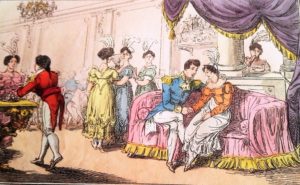 What did this mean for their families, especially the women? My novels are set against this backdrop of an off-stage war in a patriarchal world where women had few or no rights or opportunities and were open to abuse and exploitation by those whom society expected to protect them. They had very little security but were held to an impossibly high moral standard. There were only two sorts of women, good and bad, and a lost reputation could never be redeemed.
What did this mean for their families, especially the women? My novels are set against this backdrop of an off-stage war in a patriarchal world where women had few or no rights or opportunities and were open to abuse and exploitation by those whom society expected to protect them. They had very little security but were held to an impossibly high moral standard. There were only two sorts of women, good and bad, and a lost reputation could never be redeemed.
In my new novel, A Suggestion of Scandal, governess Rosa Fancourt remembers the day when her world crumbled around her. After her father’s death in battle, her mother had remarried. Now she, too, had died. Her father’s solicitor has called to Rosa’s school in Bath to break the news. He also tells her that her stepfather refuses to accept her into his household. From now on, she is on her own.
A Suggestion of Scandal opens eleven years later. Rosa, who has spent ten years as governess to Chloe Loring, is about to leave the Lorings’ employment. When she discovers two lovers in flagrante delicto, her life and future are suddenly at risk. Even if she escapes captivity, the mere suggestion of scandal is enough to ruin a lady in her situation. In Sir Julian Loring she finds an unexpected champion but will he stand by her to the end?
A Suggestion of Scandal is available worldwide from Amazon as eBook and paperback.

Catherine Kullmann was born and educated in Dublin. Following a three-year courtship conducted mostly by letter, she moved to Germany where she lived for twenty-six years before returning to Ireland. She has worked in the Irish and New Zealand public services and in the private sector.
Catherine’s debut novel, The Murmur of Masks, received a Chill with a Book Readers Award and was short-listed for Best Novel in the 2017 CAP (Carousel Aware Prize) Awards. Perception & Illusion received a Chill with a Book Readers Award and a Discovered Diamonds Award.
Be sure to learn more on Catherine's website and Facebook page.
Yorker keith
Jul 7, 2017 | 1st pages, Literary

I have heard a wise man say that love is a form of friendship, and friendship a form of love; the line between the two is misty. I happen to know that this holds true because I have roamed that misty line. Time has passed since then, but I cherish the memory of the blue roses in grace and perpetuity — our blue roses. It all began with a fortuitous encounter.
* * *
On a fine day in early April 1999, I was sketching in the sculpture court at the Metropolitan Museum of Art. I felt hesitant working in such a public space, but this was a homework assignment for the art class I was taking. The object of my sketch was a sculpture of an adorable young woman, a nude, reclining on a moss-covered rock surrounded by an abundance of flowers. The smooth texture of the white marble sensually expressed her lively body, which shone with bright sunlight beneath the glass ceiling of the court.
My drawing materials were simple, just a number 2 pencil, an eraser, and a sheet of heavy white drawing paper. The assignment was to capture the skin of a figure in as much detail as possible. I had almost completed sketching the woman’s body and was working on the rock and flowers. I was not doing badly, I thought, for a small crowd of museum visitors had gathered around me, showing approving faces and nods.
“Ah, this is excellent!” one man exclaimed.
I recognized the voice and turned to see Hans Schmidt, standing amid the crowd wearing a big grin.
“What a surprise!” he continued. “I didn’t know you had such an artistic talent, Mark. How are you?” He came forward and firmly shook my hand.
I greeted him, then pointed to my drawing. “I’ve been working on this for a while. I wasn’t sure how it would come out. But it’s coming along all right, I guess.”
“I don’t know much about drawing, but this looks great.” He gestured enthusiastically to a young woman next to him. “What do you think?”
“It’s pretty.” Her voice sounded like a bell.
“This is Yukari, my wife.” He guided her toward me, his hand lingering at the small of her back.
I swallowed. I knew Hans was married, but this was my first time to meet his wife. Hans’s wife is Japanese? How lovely she is. Hans, you devil, you’re a lucky man!
“Pleased to meet you.” I gently shook her small refined hand. “I’m Mark Sanders. Hans and I are good friends.”
 When it comes to marketing a horror movie, the trailer is everything. A good trailer can be shared all over social media and attract just the right audience to go and see it. Promoting a horror novel is much the same. Here are 5 marketing tactics horror movies use that you can also use to promote your horror novel.
When it comes to marketing a horror movie, the trailer is everything. A good trailer can be shared all over social media and attract just the right audience to go and see it. Promoting a horror novel is much the same. Here are 5 marketing tactics horror movies use that you can also use to promote your horror novel. Same is true for promoting your book. Give your readers characters they care about, with sympathetic backgrounds you can sum up in a few words you can use in your book description. This helps to put a “face” to your characters and give them life for your readers.
Same is true for promoting your book. Give your readers characters they care about, with sympathetic backgrounds you can sum up in a few words you can use in your book description. This helps to put a “face” to your characters and give them life for your readers. Keith Deininger is the award-winning and #1 Amazon bestselling author of many horror and fantasy titles, including WITHIN, THE FEVER TRILOGY and THE GODGAME series. He has been called “one of the finest writers of imaginative fiction” and “Ray Bradbury on acid.” His latest novel, VIOLENT HEARTS, has been compared to Stephen King’s fantasy-based work. He lives in Albuquerque, NM with his wife and kids. Although he loves a good nightmare, in person he’s a really nice guy. Promise.
Keith Deininger is the award-winning and #1 Amazon bestselling author of many horror and fantasy titles, including WITHIN, THE FEVER TRILOGY and THE GODGAME series. He has been called “one of the finest writers of imaginative fiction” and “Ray Bradbury on acid.” His latest novel, VIOLENT HEARTS, has been compared to Stephen King’s fantasy-based work. He lives in Albuquerque, NM with his wife and kids. Although he loves a good nightmare, in person he’s a really nice guy. Promise.


 Hunger killed thousands of them. The murderous blizzard of December 1846 killed many thousands more and brought the Works to a halt all across the country. But they opened again in January 1847, and the arctic cold went on. By the time the soup kitchens took over in March, the Works were employing three-quarters of a million survivors, mostly in the West of Ireland, all trying desperately to feed their families on pitifully low wages. Then, as the winter receded, a vicious fever epidemic killed hundreds of thousands of people right across Ireland. 1846 was shocking, but Black ’47 would never be forgotten.
Hunger killed thousands of them. The murderous blizzard of December 1846 killed many thousands more and brought the Works to a halt all across the country. But they opened again in January 1847, and the arctic cold went on. By the time the soup kitchens took over in March, the Works were employing three-quarters of a million survivors, mostly in the West of Ireland, all trying desperately to feed their families on pitifully low wages. Then, as the winter receded, a vicious fever epidemic killed hundreds of thousands of people right across Ireland. 1846 was shocking, but Black ’47 would never be forgotten.






 The simplest way to describe the Regency is ‘the period between hoops and crinolines’. Beautiful Empire gowns, light muslins, gentlemen in severely tailored riding clothes and highly polished boots, Mr Darcy and Elizabeth Bennet, waltzes, quadrilles and the Battle of Waterloo.
The simplest way to describe the Regency is ‘the period between hoops and crinolines’. Beautiful Empire gowns, light muslins, gentlemen in severely tailored riding clothes and highly polished boots, Mr Darcy and Elizabeth Bennet, waltzes, quadrilles and the Battle of Waterloo. Society in the new United Kingdom was dominated by the aristocracy and great landowners who not only filled the House of Lords but also, through an unequal franchise coupled with outdated constituency borders, controlled much of the House of Commons. In
Society in the new United Kingdom was dominated by the aristocracy and great landowners who not only filled the House of Lords but also, through an unequal franchise coupled with outdated constituency borders, controlled much of the House of Commons. In  A series of ‘Gagging Acts’ sought to prevent any hint of sedition and libel. The military were used to suppress demonstrations, culminating in the infamous Peterloo massacre in 1819 when cavalry charged the crowd at a reform meeting in Manchester, leaving over four hundred injured and eleven to fifteen people dead, including a two-year-old boy.
A series of ‘Gagging Acts’ sought to prevent any hint of sedition and libel. The military were used to suppress demonstrations, culminating in the infamous Peterloo massacre in 1819 when cavalry charged the crowd at a reform meeting in Manchester, leaving over four hundred injured and eleven to fifteen people dead, including a two-year-old boy. The Napoleonic wars lasted twelve years. Unlike the other combatants, the UK was spared the havoc wrought by an invading army and did not suffer under an army of occupation. The war happened elsewhere, far away. People were generally unaware of its progress—the only available news was that provided in official dispatches published in
The Napoleonic wars lasted twelve years. Unlike the other combatants, the UK was spared the havoc wrought by an invading army and did not suffer under an army of occupation. The war happened elsewhere, far away. People were generally unaware of its progress—the only available news was that provided in official dispatches published in  What did this mean for their families, especially the women? My novels are set against this backdrop of an off-stage war in a patriarchal world where women had few or no rights or opportunities and were open to abuse and exploitation by those whom society expected to protect them. They had very little security but were held to an impossibly high moral standard. There were only two sorts of women, good and bad, and a lost reputation could never be redeemed.
What did this mean for their families, especially the women? My novels are set against this backdrop of an off-stage war in a patriarchal world where women had few or no rights or opportunities and were open to abuse and exploitation by those whom society expected to protect them. They had very little security but were held to an impossibly high moral standard. There were only two sorts of women, good and bad, and a lost reputation could never be redeemed.


